Unraveling the Role of Human Activities and Climate Variability in Water Level Changes in the Taihu Plain Using Artificial Neural Network
Abstract
1. Introduction
2. Study Area and Data
2.1. Study Area
2.2. Data Preparation
3. Methodology
3.1. Statistical Analysis
3.2. ANN-Based Attribution Analysis
4. Results and Discussions
4.1. Variability of Annual and Seasonal Water Level
4.2. The Relative Impact of Climate Variability and Human Activities on Water Level Changes
4.2.1. MLP Model Setup
4.2.2. Contribution Analysis to Water Level Changes
4.3. Discussion
4.3.1. Impacts of Human Activities on Water Level Changes
4.3.2. Limitations and Recommendations for Future Research
5. Conclusions
Author Contributions
Funding
Acknowledgments
Conflicts of Interest
References
- Milly, P.; Wetherald, R.; Dunne, K.; Delworth, T. Increasing risk of great floods in a changing climate. Nature 2002, 415, 514–517. [Google Scholar] [CrossRef]
- Seyoum, W.; Milewski, A.; Durham, M. Understanding the relative impacts of natural processes and human activities on the hydrology of the central rift valley lakes, east Africa. Hydrol. Process. 2015, 29, 4312–4324. [Google Scholar] [CrossRef]
- Dey, P.; Mishra, A. Separating the impacts of climate change and human activities on streamflow: A review of methodologies and critical assumptions. J. Hydrol. 2017, 548, 278–290. [Google Scholar] [CrossRef]
- Li, C.; Wang, L.; Wang, W.; Qi, J.; Yang, L.; Zhang, Y.; Wu, L.; Cui, X.; Wang, P. An analytical approach to separate climate and human contributions to basin streamflow variability. J. Hydrol. 2018, 559, 30–42. [Google Scholar] [CrossRef]
- Hannaford, J.; Buys, G.; Stahl, K.; Tallaksen, L.M. The influence of decadal-scale variability on trends in long European streamflow records. Hydrol. Earth Syst. Sci. 2013, 17, 2717–2733. [Google Scholar] [CrossRef]
- Wang, Y.; Chen, X.; Ying, C.; Liu, M.; Gao, L. Flood/drought event identification using an effective indicator based on the correlations between multiple time scales of the standardized precipitation index and river discharge. Theor. Appl. Climatol. 2017, 128, 159–168. [Google Scholar] [CrossRef]
- Wang, Y.; Xu, Y.; Lei, C.; Li, G.; Han, L.; Song, S.; Yang, L.; Deng, X. Spatio-temporal characteristics of precipitation and dryness/wetness in Yangtze River Delta, eastern China, during 1960–2012. Atmos. Res. 2016, 173, 196–205. [Google Scholar] [CrossRef]
- Lai, X.; Jiang, J.; Yang, G.; Lu, X.X. Should the Three Gorges Dam be blamed for the extremely low water levels in the middle-lower Yangtze River? Hydrol. Process. 2014, 28, 150–160. [Google Scholar] [CrossRef]
- Song, S.; Xu, Y.P.; Zhang, J.X.; Li, G.; Wang, Y.F. The long-term water level dynamics during urbanization in plain catchment in Yangtze River Delta. Agric. Water Manag. 2016, 174, 93–102. [Google Scholar] [CrossRef]
- Das, M.; Ghosh, S.K.; Chowdary, V.M.; Saikrishnaveni, A.; Sharma, R.K. A probabilistic nonlinear model for forecasting daily water level in reservoir. Water Resour. Manag. 2016, 30, 3107–3122. [Google Scholar] [CrossRef]
- Chen, Y.D.; Zhang, Q.; Xu, C.-Y.; Yang, T.; Chen, X.; Jiang, T. Change-point alterations of extreme water levels and underlying causes in the Pearl River Delta, China. River Res. Appl. 2009, 25, 1153–1168. [Google Scholar] [CrossRef]
- Seo, Y.; Kim, S.; Kisi, O.; Singh, V.P. Daily water level forecasting using wavelet decomposition and artificial intelligence techniques. J. Hydrol. 2015, 520, 224–243. [Google Scholar] [CrossRef]
- Doell, P.; Zhang, J. Impact of climate change on freshwater ecosystems: A global-scale analysis of ecologically relevant river flow alterations. Hydrol. Earth Syst. Sci. 2010, 14, 783–799. [Google Scholar] [CrossRef]
- Ye, X.; Xu, C.Y.; Zhang, Q.; Yao, J.; Li, X. Quantifying the human induced water level decline of China’s largest freshwater lake from the changing underlying surface in the lake region. Water Resour. Manag. 2018, 32, 1467–1482. [Google Scholar] [CrossRef]
- Yamazaki, D.; Lee, H.; Alsdorf, D.E.; Dutra, E.; Kim, H.; Kanae, S.; Oki, T. Analysis of the water level dynamics simulated by a global river model: A case study in the Amazon River. Water Resour. Res. 2012, 48. [Google Scholar] [CrossRef]
- Assani, A.; Landry, R.; Biron, S.; Frenette, J. Analysis of the interannual variability of annual daily extreme water levels in the St Lawrence River and Lake Ontario from 1918 to 2010. Hydrol. Process. 2014, 28, 4011–4022. [Google Scholar] [CrossRef]
- Zhao, Y.; Zou, X.; Gao, J.; Xu, X.; Wang, C.; Tang, D.; Wang, T.; Wu, X. Quantifying the anthropogenic and climatic contributions to changes in water discharge and sediment load into the sea: A case study of the Yangtze River, China. Sci. Total Environ. 2015, 536, 803–812. [Google Scholar] [CrossRef] [PubMed]
- Yuan, Y.; Zeng, G.; Liang, J.; Huang, L.; Hua, S.; Li, F.; Zhu, Y.; Wu, H.; Liu, J.; He, X.; et al. Variation of water level in Dongting Lake over a 50-year period: Implications for the impacts of anthropogenic and climatic factors. J. Hydrol. 2015, 525, 450–456. [Google Scholar] [CrossRef]
- Shao, G.; Guan, Y.; Zhang, D.; Yu, B.; Zhu, J. The impacts of climate variability and land use change on streamflow in the Hailiutu river basin. Water 2018, 10, 814. [Google Scholar] [CrossRef]
- Tian, L.; Jin, J.; Wu, P.; Niu, G. Quantifying the impact of climate change and human activities on streamflow in a semi-arid watershed with the budyko equation incorporating dynamic vegetation information. Water 2018, 10, 1781. [Google Scholar] [CrossRef]
- Zhang, W.; Yan, Y.; Zheng, J.; Li, L.; Dong, X.; Cai, H. Temporal and spatial variability of annual extreme water level in the Pearl River Delta region, China. Glob. Planet. Chang. 2009, 69, 35–47. [Google Scholar] [CrossRef]
- Xu, G.; Xu, Y.; Luo, X.; Xu, H.; Xu, X.; Hu, C. Temporal and spatial variation of water level in urbanizing plain river network region. Water Sci. Technol. 2014, 69, 2191–2199. [Google Scholar] [CrossRef] [PubMed]
- Cochrane, T.A.; Arias, M.E.; Piman, T. Historical impact of water infrastructure on water levels of the Mekong River and the Tonle Sap system. Hydrol. Earth Syst. Sci. 2014, 18, 4529–4541. [Google Scholar] [CrossRef]
- Deng, X.; Xu, Y.; Han, L.; Yang, M.; Yang, L.; Song, S.; Li, G.; Wang, Y. Spatial-temporal evolution of the distribution pattern of river systems in the plain river network region of the Taihu Basin, China. Quat. Int. 2016, 392, 178–186. [Google Scholar] [CrossRef]
- Liu, L.; Xu, Z.; Reynard, N.; Hu, C.; Jones, R. Hydrological analysis for water level projections in Taihu Lake, China. J. Flood Risk Manag. 2013, 6, 14–22. [Google Scholar] [CrossRef]
- Wang, L.; Cai, Y.; Chen, H.; Daler, D.; Zhao, J.; Yang, J. Flood disaster in Taihu Basin, China: Causal chain and policy option analyses. Environ. Earth Sci. 2010, 63, 1119–1124. [Google Scholar] [CrossRef]
- Wang, Y.; Song, H.; Chao, Y.; Chang, H. The flood risk and flood alleviation benefit of land use management in Taihu Basin. J. Hydraul. Eng. 2013, 44, 327–335. (In Chinese) [Google Scholar]
- Govindaraju, R.S.; Rao, A.R. Artificial Neural Networks in Hydrology; Springer Science & Business Media: Berlin, Germany, 2013. [Google Scholar]
- Singh, A.; Imtiyaz, M.; Isaac, R.K.; Denis, D.M. Comparison of soil and water assessment tool (SWAT) and multilayer perceptron (MLP) artificial neural network for predicting sediment yield in the Nagwa agricultural watershed in Jharkhand, India. Agric. Water Manag. 2012, 104, 113–120. [Google Scholar] [CrossRef]
- Tabari, H.; Talaee, P.H. Multilayer perceptron for reference evapotranspiration estimation in a semiarid region. Neural Comput. Appl. 2013, 23, 341–348. [Google Scholar] [CrossRef]
- Moghim, S.; Bras, R. Bias correction of climate modeled temperature and precipitation using artificial neural networks. J. Hydrometeorol. 2017, 18, 1867–1884. [Google Scholar] [CrossRef]
- Kisi, O.; Yaseen, Z.M. The potential of hybrid evolutionary fuzzy intelligence model for suspended sediment concentration prediction. Catena 2019, 174, 11–23. [Google Scholar] [CrossRef]
- Yang, M.; Xu, Y.; Pan, G.; Han, L. Impacts of urbanization on precipitation in Taihu Lake Basin, China. J. Hydrol. Eng. 2014, 19, 739–746. [Google Scholar] [CrossRef]
- Yuan, J.; Xu, Y.; Wu, L.; Wang, J.; Wang, Y.; Xu, Y.; Dai, X. Variability of precipitation extremes over the Yangtze River Delta, eastern China, during 1960–2016. Theor. Appl. Climatol. 2019, 1–15. [Google Scholar] [CrossRef]
- Ning, J.; Liu, G.; Liu, Q.; Xie, C. Land use change and ecological environment evolution in Taihu Lake basin. In Proceedings of the 18th International Conference on Geoinformatics, Beijing, China, 18–20 June 2010. [Google Scholar]
- National Bureau of Statistics of Jiangsu. Jiangsu Statistical Yearbook 2015; China Statistics Press: Beijing, China, 2015. (In Chinese)
- Chen, Z.; Wang, Z. Yangtze Delta, China: Taihu lake-level variation since the 1950s, response to sea-level rise and human impact. Environ. Geol. 1999, 37, 333–339. [Google Scholar] [CrossRef]
- Wei, W.; Tang, Z.; Dai, Z.; Lin, Y.; Ge, Z.; Gao, J. Variations in tidal flats of the Changjiang (Yangtze) estuary during 1950s–2010s: Future crisis and policy implication. Ocean Coast. Manag. 2015, 108, 89–96. [Google Scholar] [CrossRef]
- Cheng, X.; Evans, E.; Wu, H.; Thorne, C.; Han, S.; Simm, J.; Hall, J. A framework for long-term scenario analysis in the Taihu Basin, China. J. Flood Risk Manag. 2013, 6, 3–13. [Google Scholar] [CrossRef]
- Pettitt, A.N. A non-parametric approach to the change-point problem. Appl. Stat. 1979, 28, 126–135. [Google Scholar] [CrossRef]
- Sneyers, R. On the Statistical Analysis of Series of Observations; World Meteorological Organization: Geneva, Switzerland, 1990. [Google Scholar]
- Mann, H. Nonparametric tests against trend. Econometrica 1945, 13, 245–259. [Google Scholar] [CrossRef]
- Kendall, M.G. Rank Correlation Methods; Charles Griffin Book Series; Oxford University Press: Oxford, UK, 1975. [Google Scholar]
- Shifteh Some’e, B.; Ezani, A.; Tabari, H. Spatiotemporal trends and change point of precipitation in Iran. Atmos. Res. 2012, 113, 1–12. [Google Scholar] [CrossRef]
- Tabari, H.; Taye, M.; Willems, P. Statistical assessment of precipitation trends in the upper Blue Nile River basin. Stoch. Environ. Res. Risk Assess 2015, 29, 1751–1761. [Google Scholar] [CrossRef]
- Milad, N.; Mohammad, B. Spatiotemporal changes in aridity index and reference evapotranspiration over semi-arid and humid regions of Iran: Trend, cause, and sensitivity analyses. Theor. Appl. Climatol. 2018, 1–12. [Google Scholar] [CrossRef]
- Wang, G.; Zhang, J.; He, R.; Jiang, N.; Jing, X. Runoff reduction due to environmental changes in the Sanchuanhe river basin. Int. J. Sediment Res. 2008, 23, 174–180. [Google Scholar] [CrossRef]
- Tabari, H.; Marofi, S.; Sabziparvar, A. Estimation of daily pan evaporation using artificial neural network and multivariate non-linear regression. Irrig. Sci. 2010, 28, 399–406. [Google Scholar] [CrossRef]
- Rezaeianzadeh, M.; Stein, A.; Tabari, H.; Abghari, H.; Jalalkamali, N.; Zia Hosseinipour, E.; Singh, V.P. Comparative assessment of a conceptual hydrological model and artificial neural networks for daily outflows forecasting. Int. J. Environ. Sci. Technol. 2013, 10, 1181–1192. [Google Scholar] [CrossRef]
- Mukherjee, A.; Ramachandran, P. Prediction of GWL with the help of GRACE TWS for unevenly spaced time series data in India.: Analysis of Comparative Performances of SVR, ANN and LRM. J. Hydrol. 2018, 147, 4463. [Google Scholar] [CrossRef]
- Sajikumar, N.; Thandaveswara, B.S. A non-linear rainfall runoff model using artificial neural network. J. Hydrol. 1999, 216, 32–55. [Google Scholar] [CrossRef]
- Tsoukalas, L.H.; Uhrig, R.E. Fuzzy and Neural Approaches in Engineering; Wiley InterScience: New York, NY, USA, 1997. [Google Scholar]
- Luk, K.; Ball, J.; Sharma, A. A study of optimal model lag and spatial inputs to artificial neural network for rainfall forecasting. J. Hydrol. 2000, 227, 56–65. [Google Scholar] [CrossRef]
- Yin, Y.; Xu, Y.; Chen, Y. Maximum water level of Taihu Lake and its relation to the climate change ang human activities. Resour. Environ. Yangtze Basin 2009, 18, 609–614. (In Chinese) [Google Scholar]
- Xu, Y.; Xu, J.; Ding, J.; Chen, Y.; Yin, Y.; Zhang, X. Impacts of urbanization on hydrology in the Yangtze River Delta, China. Water Sci. Technol. 2010, 62, 1221–1229. [Google Scholar] [CrossRef]
- Penning-Rowsell, E.; Yanyan, W.; Watkinson, A.; Jiang, J.; Thorne, C. Socioeconomic scenarios and flood damage assessment methodologies for the Taihu Basin, China. J. Flood Risk Manag. 2013, 6, 23–32. [Google Scholar] [CrossRef]
- Lin, H.; Cheng, A.; Mei, Q.; Xu, J. Studies on warning water level of Taihu Lake. China Water Resour. 2014, 745, 55–57. (In Chinses) [Google Scholar]
- Wang, Y.; Tabari, H.; Xu, Y.; Willems, P. Atmospheric and human induced impacts on temporal variability of water level extremes in the Taihu Basin, China. J. Flood Risk Manag. 2019, 1–14. [Google Scholar] [CrossRef]
- Zhang, E.; Savenije, H.; Chen, S.; Chen, J. Water abstraction along the lower Yangtze River, China, and its impact on water discharge into the estuary. Phys. Chem. Earth 2012, 47–48, 76–85. [Google Scholar] [CrossRef]
- Liu, W. Water Abstraction along the Yangtze River Downstream from Datong to Estuary and Its Impact on Water Discharge into Estuary. Master’s Thesis, East China Normal University, Shanghai, China, 2016. (In Chinese). [Google Scholar]
- Hao, L.; Sun, G.; Liu, Y.; Wan, J.; Qin, M.; Qian, H.; Liu, C.; Zheng, J.; John, R.; Fan, P.; et al. Urbanization dramatically altered the water balances of a paddy field-dominated basin in southern China. Hydrol. Earth Syst. Sci. 2015, 19, 3319–3331. [Google Scholar] [CrossRef]
- Wu, J.; Miao, C.; Wang, Y.; Duan, Q.; Zhang, X. Contribution analysis of the long-term changes in seasonal runoff on the Loess Plateau, China using eight Budyko-based methods. J. Hydrol. 2017, 545, 263–275. [Google Scholar] [CrossRef]
- Yin, Y.; Xu, Y.; Chen, Y. Relationship between changes of river-lake networks and water levels in typical regions of Taihu Lake Basin, China. Chin. Geogr. Sci. 2012, 22, 673–682. [Google Scholar] [CrossRef]
- Yang, L.; Xu, Y.; Han, L.; Song, S.; Deng, X.; Wang, Y. River networks system changes and its impact on storage and flood control capacity under rapid urbanization. Hydrol. Process. 2016, 30, 2401–2412. [Google Scholar] [CrossRef]
- Wang, J.; Xu, Y.; Wang, Y.; Yuan, J.; Wang, Q.; Xiang, J. Non-stationarity analysis of extreme water level in response to climate change and urbanization in the Taihu Basin, China. Stoch. Environ. Res. Risk Assess. 2019, 1–14. [Google Scholar] [CrossRef]
- Zheng, H.; Zhang, L.; Zhu, R.; Liu, C.; Sato, Y.; Fukushima, Y. Responses of streamflow to climate and land surface change in the headwaters of the Yellow River Basin. Water Resour. Res. 2009, 45. [Google Scholar] [CrossRef]
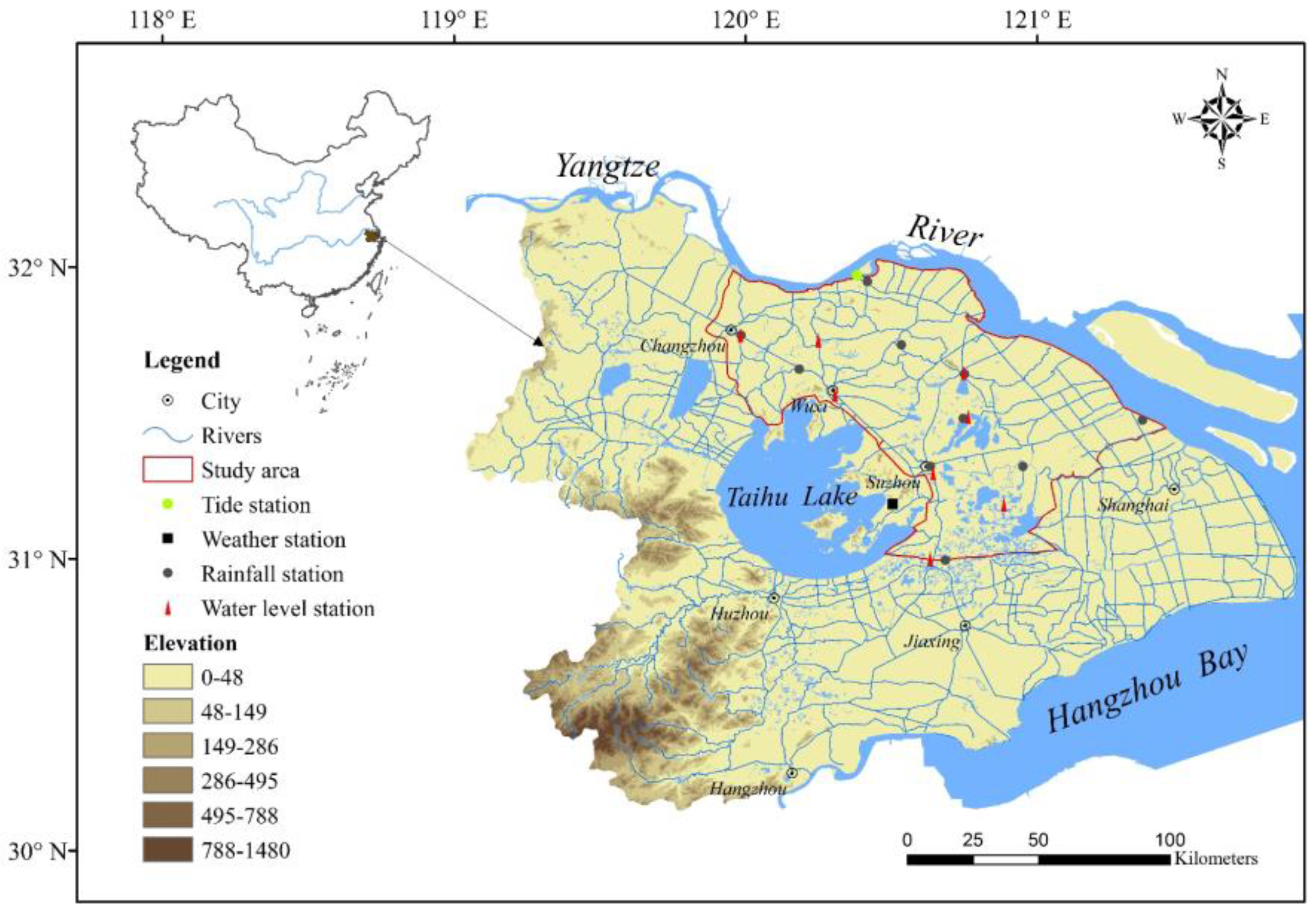
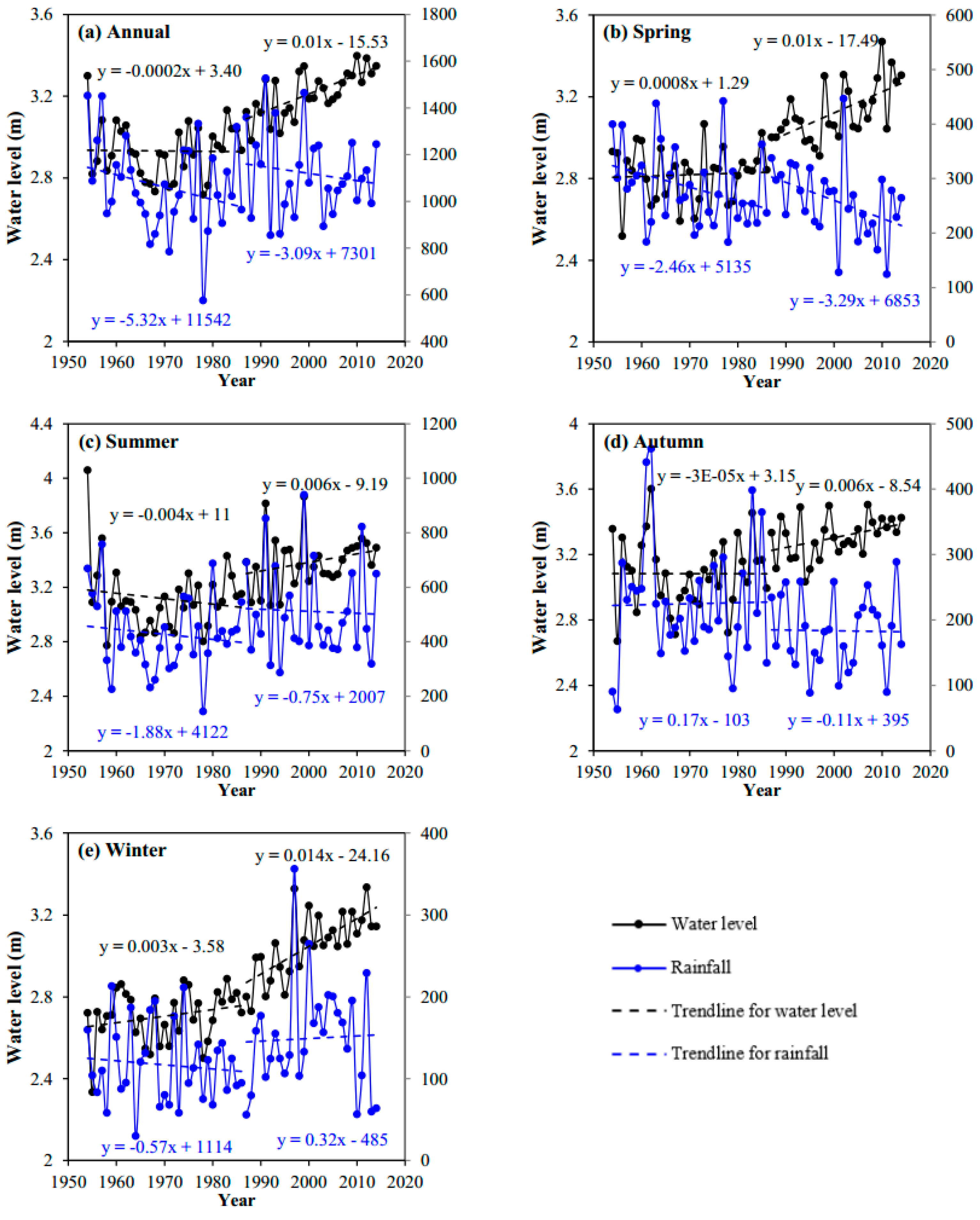
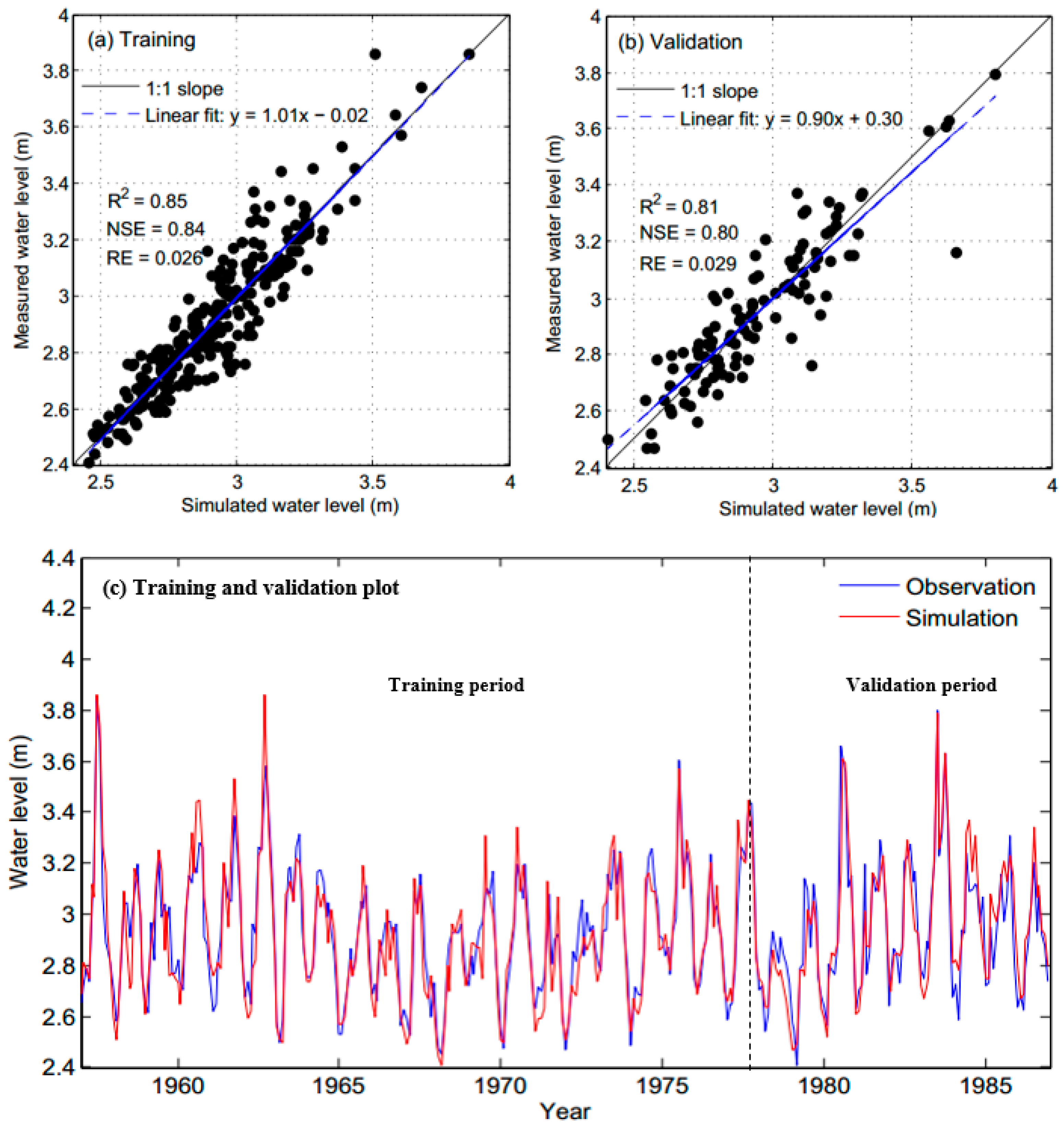
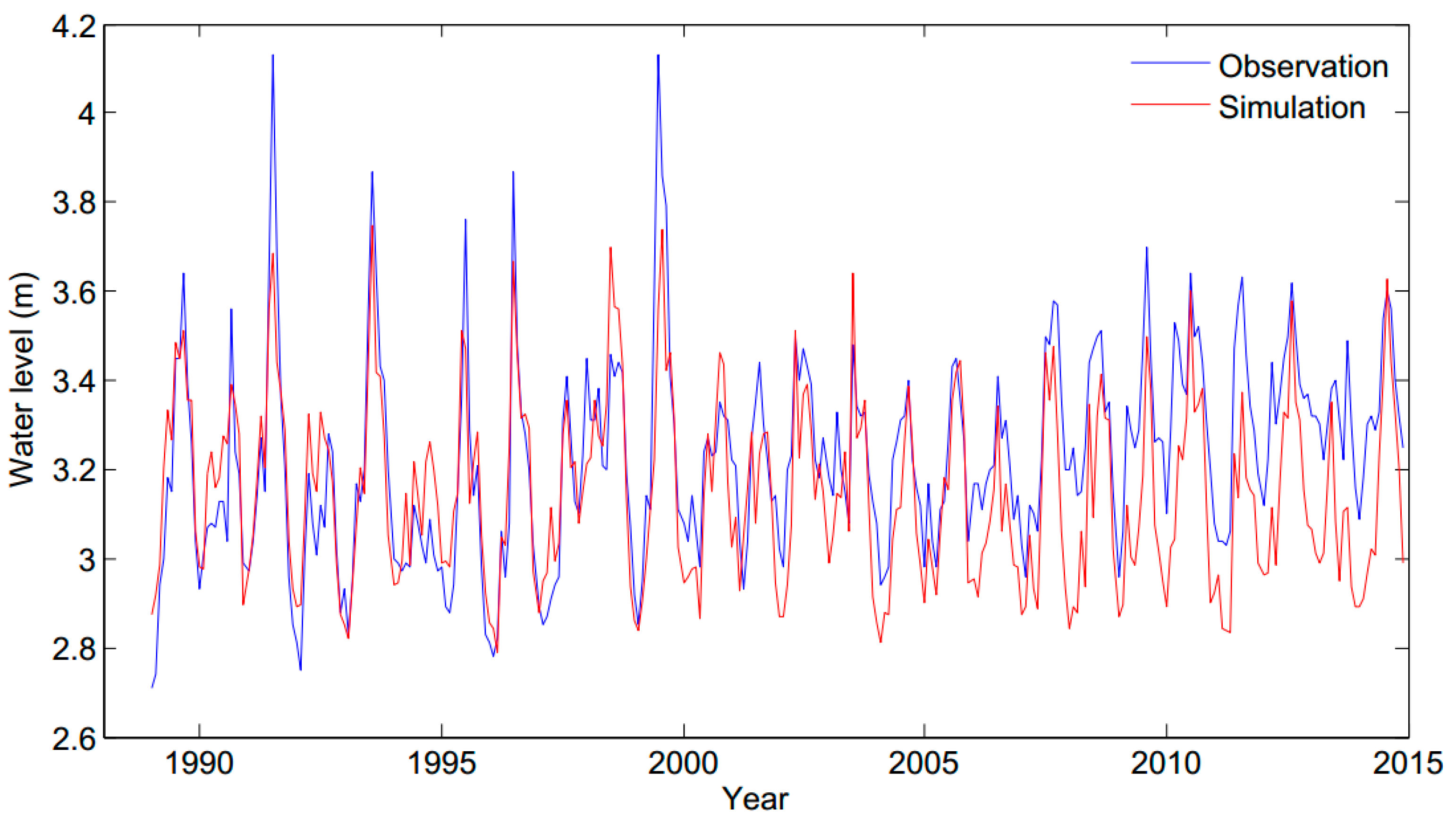
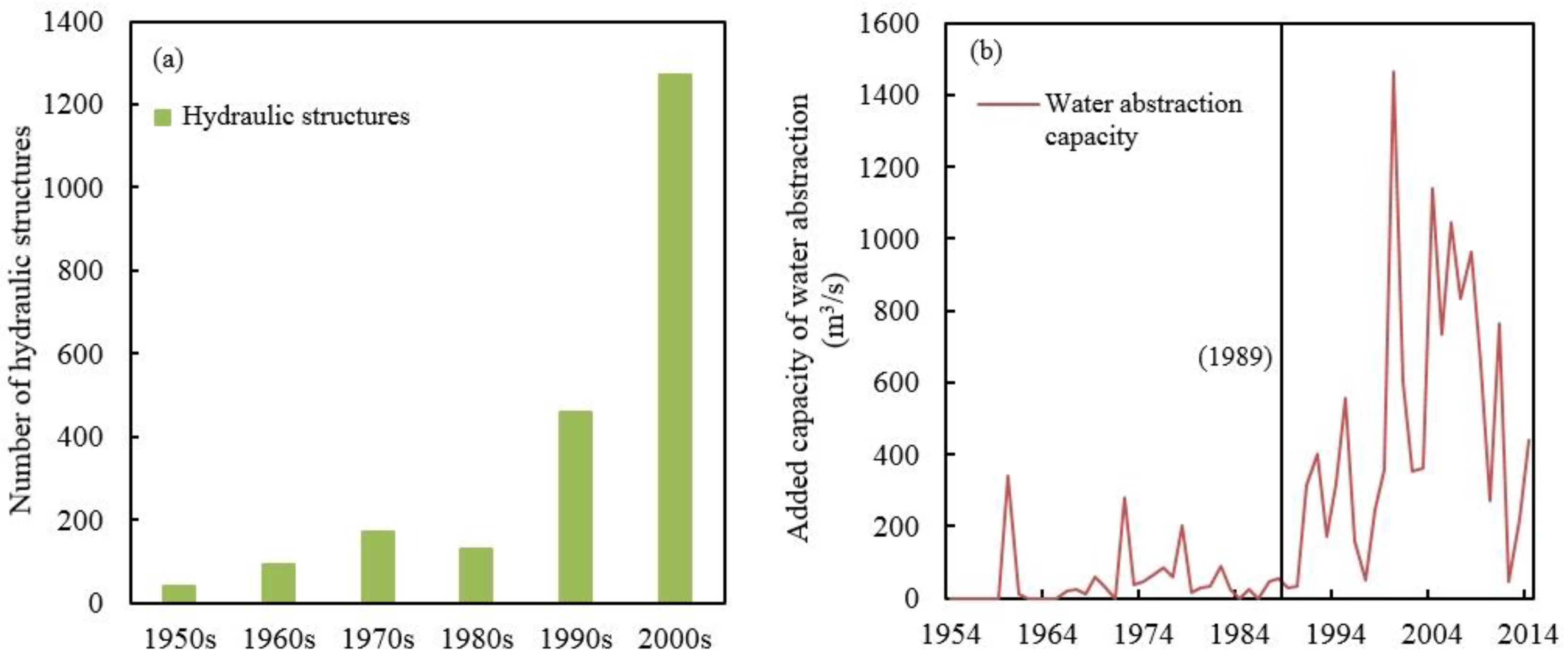

| Station Name | Measuring Variable | Longitude (°E) | Latitude (°N) | Mean Value 1 | CV | Period of Record |
|---|---|---|---|---|---|---|
| Changshu | Rainfall | 120.75 | 31.63 | 1063.9 | 0.20 | 1954–2014 |
| Changzhou | 119.98 | 31.76 | 1100.9 | 0.20 | 1954–2014 | |
| Chenshu | 120.53 | 31.66 | 1062.5 | 0.19 | 1954–2014 | |
| Liuhezha | 121.27 | 31.50 | 1099.5 | 0.19 | 1954–2014 | |
| Pingwang | 120.27 | 31.00 | 1129.6 | 0.20 | 1954–2014 | |
| Suzhou | 120.63 | 31.31 | 1113.5 | 0.20 | 1954–2014 | |
| Wuxi | 120.28 | 31.55 | 1112.1 | 0.19 | 1954–2014 | |
| Xiangcheng | 120.74 | 31.47 | 1066.6 | 0.19 | 1954–2014 | |
| Zhangjiagang | 120.53 | 31.95 | 1077.4 | 0.21 | 1962–2014 | |
| Zhouxiang | 120.97 | 31.40 | 1094.2 | 0.19 | 1954–2014 | |
| Changshu | Water level | 120.75 | 31.64 | 3.0 | 0.06 | 1954–2014 |
| Changzhou | 119.98 | 31.77 | 3.3 | 0.06 | 1954–2014 | |
| Chenmu | 120.88 | 31.18 | 2.6 | 0.07 | 1962–2014 | |
| Pingwang | 120.63 | 31.00 | 2.9 | 0.06 | 1954–2014 | |
| Qingyang | 120.25 | 31.75 | 3.2 | 0.08 | 1954–2014 | |
| Suzhou | 120.64 | 31.29 | 2.9 | 0.07 | 1954–2014 | |
| Wuxi | 120.31 | 31.57 | 3.1 | 0.07 | 1954–2014 | |
| Xiangcheng | 120.73 | 31.48 | 3.0 | 0.06 | 1954–2014 | |
| Jiangyin | Tide level | 120.34 | 31.96 | 3.2 | 0.12 | 1954–2014 |
| Dongshan | Evaporation | 120.50 | 31.17 | 848.3 | 0.11 | 1954–2014 |
| Pettitt | Mann-Kendall | Sequential Cluster | ||||||
|---|---|---|---|---|---|---|---|---|
| Change Point | H0 | Change Point | H0 | Change Point | H0 | |||
| Annual | 1988 | R | 1990 | R | 1988 | R | ||
| MAM | 1986 | R | 1987 | R | 1986 | R | ||
| JJA | 1986 | R | 1988 | R | 1989 | R | ||
| SON | 1986 | R | 1987 | R | 1986 | R | ||
| DJF | 1988 | R | 1989 | R | 1988 | R | ||
| Mann–Whitney Test | Baseline Period | Evaluation Period | |||||||
|---|---|---|---|---|---|---|---|---|---|
| n1 | n2 | Zc | Mean (m) | SD (m) | CV | Mean (m) | SD (m) | CV | |
| Annual | 35 | 26 | −5.95 * | 2.94 | 0.13 | 0.018 | 3.23 | 0.10 | 0.011 |
| MAM | 33 | 28 | −6.20 * | 2.82 | 0.13 | 0.018 | 3.13 | 0.14 | 0.020 |
| JJA | 33 | 28 | −4.58 * | 3.12 | 0.25 | 0.066 | 3.39 | 0.19 | 0.037 |
| SON | 33 | 28 | −4.26 * | 3.08 | 0.22 | 0.047 | 3.31 | 0.12 | 0.015 |
| DJF | 35 | 26 | −6.28 * | 2.71 | 0.12 | 0.016 | 3.07 | 0.14 | 0.020 |
| Model | Inputs | Output | Model Architecture *1 | Training | Validation | |||
|---|---|---|---|---|---|---|---|---|
| R2 | NSE | R2 | NSE | |||||
| MLP1 | R(t), E(t) | W(t) | 2-6-1 | 0.48 | 0.51 | 0.46 | 0.49 | |
| MLP2 | R(t), T(t) | W(t) | 2-6-1 | 0.71 | 0.68 | 0.69 | 0.70 | |
| MLP3 | R(t), E(t), T(t) | W(t) | 3-7-1 | 0.85 | 0.84 | 0.81 | 0.80 | |
| Period | R (mm) | E (mm) | T (m) | W (m) | ηc | ηh | |
|---|---|---|---|---|---|---|---|
| Annual | Baseline period | 1037.7 | 801.4 | 3.2 | 2.9 | ||
| Evaluation period | 1115.9 | 883.6 | 3.2 | 3.2 | 69.0% | 31.0% | |
| Evaluation sub-period I | 1141.6 | 827.9 | 3.2 | 3.2 | 95.8% | 4.2% | |
| Evaluation sub-period II | 1093.9 | 931.4 | 3.2 | 3.8 | 51.3% | 48.7% | |
| MAM | Baseline period | 277.8 | 195.3 | 3.0 | 2.8 | ||
| Evaluation period | 253.6 | 241.7 | 3.1 | 3.1 | 61.3% | 38.7% | |
| Evaluation sub-period I | 275.8 | 215.6 | 3.1 | 3.1 | 87.0% | 13.0% | |
| Evaluation sub-period II | 234.6 | 264.1 | 3.1 | 3.2 | 27.0% | 73.0% | |
| JJA | Baseline period | 420.2 | 321.8 | 3.8 | 3.1 | ||
| Evaluation period | 509.9 | 342.7 | 3.8 | 3.4 | 89.7% | 10.3% | |
| Evaluation sub-period I | 521.3 | 321.1 | 3.8 | 3.40 | 92.6% | 7.4% | |
| Evaluation sub-period II | 500.0 | 361.2 | 3.8 | 3.4 | 71.9% | 28.1% | |
| SON | Baseline period | 232.6 | 185.4 | 3.4 | 3.1 | ||
| Evaluation period | 182.3 | 204.5 | 3.4 | 3.3 | 81.0% | 19.0% | |
| Evaluation sub-period I | 186.1 | 198.5 | 3.5 | 3.3 | 84.2% | 15.8% | |
| Evaluation sub-period II | 179.1 | 209.6 | 3.4 | 3.3 | 54.8% | 45.2% | |
| DJF | Baseline period | 118.5 | 97.0 | 2.5 | 2.7 | ||
| Evaluation period | 170.4 | 94.7 | 2.6 | 3.1 | 60.6% | 39.4% | |
| Evaluation sub-period I | 158.4 | 92.7 | 2.5 | 3.0 | 80.8% | 19.2% | |
| Evaluation sub-period II | 180.2 | 96.5 | 2.6 | 3.1 | 47.5% | 52.5% |
© 2019 by the authors. Licensee MDPI, Basel, Switzerland. This article is an open access article distributed under the terms and conditions of the Creative Commons Attribution (CC BY) license (http://creativecommons.org/licenses/by/4.0/).
Share and Cite
Wang, Y.; Tabari, H.; Xu, Y.; Xu, Y.; Wang, Q. Unraveling the Role of Human Activities and Climate Variability in Water Level Changes in the Taihu Plain Using Artificial Neural Network. Water 2019, 11, 720. https://doi.org/10.3390/w11040720
Wang Y, Tabari H, Xu Y, Xu Y, Wang Q. Unraveling the Role of Human Activities and Climate Variability in Water Level Changes in the Taihu Plain Using Artificial Neural Network. Water. 2019; 11(4):720. https://doi.org/10.3390/w11040720
Chicago/Turabian StyleWang, Yuefeng, Hossein Tabari, Youpeng Xu, Yu Xu, and Qiang Wang. 2019. "Unraveling the Role of Human Activities and Climate Variability in Water Level Changes in the Taihu Plain Using Artificial Neural Network" Water 11, no. 4: 720. https://doi.org/10.3390/w11040720
APA StyleWang, Y., Tabari, H., Xu, Y., Xu, Y., & Wang, Q. (2019). Unraveling the Role of Human Activities and Climate Variability in Water Level Changes in the Taihu Plain Using Artificial Neural Network. Water, 11(4), 720. https://doi.org/10.3390/w11040720






